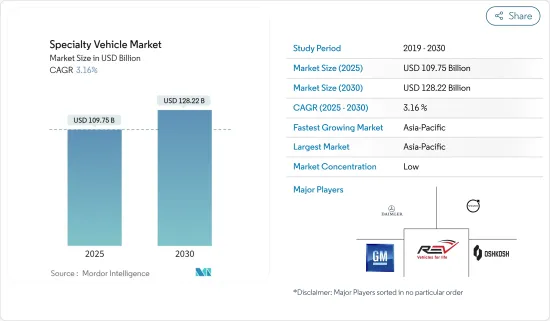PUBLISHER: Mordor Intelligence | PRODUCT CODE: 1690156

PUBLISHER: Mordor Intelligence | PRODUCT CODE: 1690156
Specialty Vehicle - Market Share Analysis, Industry Trends & Statistics, Growth Forecasts (2025 - 2030)
The Specialty Vehicle Market size is estimated at USD 109.75 billion in 2025, and is expected to reach USD 128.22 billion by 2030, at a CAGR of 3.16% during the forecast period (2025-2030).

The market for specialty vehicle market experienced a decline in 2020, primarily owing to the COVID-19 pandemic, which caused a halt in transportation activities, disrupting the supply chain. However, after the lockdown measures were revoked, the market started witnessing significant growth as governing bodies across the world started investing heavily in healthcare facilities and emergency services, and associated equipment.
Over the long term, the expansion of the construction industry in countries such as China and India, with active participation from the private sector, is expected to drive the specialized vehicle market. The expansion of the logistics sector is expected to drive the demand for special pneumatically powered bulk carriers and tank truck trailers, which will drive the bulk carrier market. Therefore, players are also focusing on developing innovative products. For instance,
Key Highlights
- In October 2022, GAZ began manufacturing commercial vehicles GAZelle Next at the AvtoVAZ Argun plant in Chechenavto. The model can also be used for school buses, ambulances, housing, and community services.
Moreover, manufacturers are also focusing on lowering costs, new service model requirements, providing appealing services due to shifting platforms, and rising material and production prices. Customers' purchasing habits in the specialty vehicle industry are changing dramatically, particularly when it comes to product customization. As the demand for customization grows, OEMs face more options and complexity.
Asia-Pacific is anticipated to witness the highest CAGR over the forecast period, followed by Europe and North America. The usage of these vehicles by small businesses in the United States for purposes such as food truck businesses, mobile showrooms, and advertising and promotions, along with the demand for travel, medical, and healthcare response vehicles, is expected to rise during the forecast period.
Specialty Vehicles Market Trends
Increase in Spending on Law Enforcement and Healthcare Facilities
The rise in epidemics and pandemics, traffic accidents, household and industrial injuries, and government-sponsored healthcare programs is driving demand for medical and healthcare specialty vehicles. Diseases such as blood cancer, which affect one person every three minutes in the United States, have increased the demand for blood, propelling the market growth for bloodmobiles.
Recent epidemics and pandemics, such as the Ebola and COVID-19 outbreaks, have increased demand for ambulances, mobile pharmacies, and mobile intensive care units. In many countries, the increase in demand for ambulances has outpaced population growth. Several countries are using advanced healthcare vehicles to cater to health emergencies. For instance, after the COVID-19 lockdown restrictions were lifted, the mobile operation theatre service resumed in New Zealand. With the rise and development of autonomous vehicle technology, emergency medical vehicles are expected to be outfitted with semi-autonomous driving assistance technology in the near future. The increase in global government spending on law enforcement and healthcare facilities is driving the demand for specialty vehicles.
Moreover, the number of specialty vehicles in use in Japan reached 1.77 million last year, up from around 1.64 million in 2012. As a result, the number of SPVs increased steadily over the previous decade.
Asia-Pacific to Exhibit the Highest Growth Rate Over the Forecast Period
Specialty Vehicles Industry Overview
Additional Benefits:
TABLE OF CONTENTS
1 INTRODUCTION
- 1.1 Study Assumptions
- 1.2 Scope of the Study
2 RESEARCH METHODOLOGY
3 EXECUTIVE SUMMARY
4 MARKET DYNAMICS
- 4.1 Market Drivers
- 4.2 Market Restraints
- 4.3 Porter's Five Forces Analysis
- 4.3.1 Threat of New Entrants
5 MARKET SEGMENTATION
6 COMPETITIVE LANDSCAPE
7 MARKET OPPORTUNITIES AND FUTURE TRENDS




